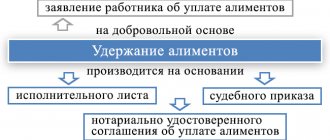Grounds for withholding alimony from wages
In order for an accountant in an organization to deduct alimony from the salaries of company employees, there must be appropriate grounds.
Voluntarily
An employee can submit an application to his employer with a request to make deductions from his salary and transfer them to certain details.
In this case, the withheld amounts of alimony can also be paid to the persons specified in the application in cash from the organization’s cash desk.
According to the employee’s application, the amount in which the accountant must make calculations from his salary is also determined.
By the tribunal's decision
The recipient of alimony or his representative may apply to the court, which, if there are substantial grounds, will issue a court ruling or a court order obliging the company employee to make payments to the specified recipients of alimony.
This method refers to forced collection. After the decision is made, the recipient will be able to contact the bailiff service, who will ensure the execution of the court decision on collection.
When this document is received by the accounting department, the payroll specialist must carry out deductions without fail, otherwise measures of appropriate liability may be applied to him.
The package sent by the bailiffs to the accounting department includes the bailiff's orders, the original or copy of the court order, court rulings, details of the alimony recipient, etc.
During a divorce, former spouses can sign an agreement to pay alimony. If they notarize this document, then it also takes on the status of a binding document. According to it, the accounting department must make deductions without fail. This agreement, certified by a notary, acquires the force of a court decision.
It is important to take into account that collection begins from the moment the organization receives a writ of execution and terminates either at the time of dismissal of the employee, or the child reaches the age of majority, or other circumstances when the writ of execution is considered terminated.
The procedure for transferring funds for child support by court decision
The calculation of alimony established in accordance with a court decision has a certain procedure.
First of all, the accounting department must be provided with a writ of execution, which is issued only in court. In some cases, the document that serves as the basis for the transfer of alimony from the income portion of the alimony payer may be a court order, as well as a resolution of the bailiff (if the judicial authorities oblige to pay alimony forcibly).
After documents are received by the accounting department, their compliance with the requirements established for registration must first be checked. If there is an error, inaccuracy or unreadability of the lines, then such documents cannot be the basis for collecting alimony, and the accounting department should not accept them.
Accounting should calculate alimony only on the basis of the original document.
If the original document is lost, then a duplicate of it is issued by the court in accordance with the established procedure. If the document is executed correctly, the organization must immediately begin to execute it. First of all, the employee must familiarize himself with the writ of execution for signature. Then the accountant must determine from which employee payments to withhold alimony.
Based on the general rule, alimony is collected both from official income from the main type of activity and for work performed part-time.
Thus, alimony is withheld from all income, which includes bonuses, allowances, compensation for working conditions, etc. However, the maximum amount of collection should not exceed 50% of total income and 70% in the case of alimony arrears.
What payments can be withheld?
The law establishes a list of payments in favor of the employee for which alimony can be applied.
Deductions must be made:
- From all types of remuneration for the employee’s work - salaries, bonuses, additional payments and allowances both at the main place of work and part-time. This list includes additional payments for skill and length of service.
- From amounts accrued based on average earnings - vacation pay and other cases of application of average earnings.
- From disability benefits (sick leave) - only if there is a writ of execution.
- With financial assistance, with the exception of one-time assistance.
- From amounts received by the employee in kind.
- From scholarships.
- From pensions.
- From unemployment benefits.
- From income from rental property.
- From income from business activities, fees, etc.
- From income from shares and similar income.
From what payments can alimony be withheld?
The legislation also establishes a list of payments to the employee that cannot be recovered for alimony.
These include:
- Compensation for harm caused to the health of an employee.
- Compensation for damage in connection with the death of the breadwinner.
- For reimbursement of travel expenses, daily allowances, etc.
- Reimbursement for wear and tear of equipment owned by the employee, compensation for the use of personal transport.
- One-time financial assistance.
- Amounts of payments as a result of accidents, catastrophes, other emergency circumstances, as well as as a result of terrorist acts.
- With humanitarian aid.
How to pay arrears of alimony to bailiffs
If there are no valid reasons for non-payment, then the most correct decision is to repay the debt as soon as possible. There are many convenient ways to pay child support debt. For example, you can do this directly on the FSSP website:
- Enter your full name. and date of birth on the page of the Data Bank of Enforcement Proceedings in the “Search for Individuals” tab.
- Select your enforcement proceedings in the list and click the “Pay” button:
- Choose a suitable payment method, including bank cards, Yandex Money, Qiwi Wallet, Google Pay. A fee may apply when paying:
- You can also generate a receipt on the FSSP portal and apply with it to any bank branch to repay your alimony debt.
You can also pay off your debt:
- In any Euroset store, when paying, you will need to pay a commission in the amount of 1.5% of the payment amount.
- Via online banking using a receipt or payment details. For example, in “Sberbank Online” you need to go to the “Payments” tab – “Taxes, fines, duties, budget payments” – “Licenses, security, law and order”.
- Through terminals that are installed in the bailiff service department.
- On the State Services website in your personal account. Typically, “Payment” receipts are shown in your personal account in the “Payment” tab:
If there is no data in the system, but there is a debt, you can enter the Unique Accrual Identifier (UIN) of the receipt in the search bar - the identifier of the payment document:
You can also go to State Services directly from the FSSP website, at the stage of choosing payment methods.
The record of the existence of a debt will disappear from the Data Bank of Enforcement Proceedings within 3-7 days after payment. It is recommended to keep all receipts confirming the fact of repayment of the debt: in the event of a failure, they will become indisputable proof of payment.
Maximum retention percentage
The Labor Code establishes that the maximum amount of deductions from an employee’s earnings cannot exceed 20% of the amount remaining after tax withholding.
However, this rule does not apply to deductions that are made according to a writ of execution. In this situation, more than 50% of the employee’s income cannot be withheld from earnings.
But there are also exceptions. If the withholding is made on minor children, compensation for harm caused to health, harm due to the loss of a breadwinner, as well as to cover damage due to the commission of a crime - no more than 70%.
Sometimes a situation may arise that the amount of deductions for several writs of execution will be greater than the maximum possible amount for deduction.
Attention! In such a situation, payments are made proportionally. In addition, it is necessary to maintain a special register in which to record the amounts withheld and which could not be withheld due to a lack of income.
How is payment processed?
Receive a writ of execution
An accountant cannot independently decide to withhold alimony from an employee.
To do this, you must obtain originals of the following documents:
- writ of execution;
- Court order;
- Notarial agreement on payment of alimony.
If the writ of execution was received in the form of a copy, then the employer can request the original document from the bailiff, or ignore this fact altogether. However, in such a situation, it may turn out that by the time the original document appears, a significant debt has accumulated.
If the company receives a bailiff's order, the writ of execution can be attached as a copy.
Attention! If an employee intends to pay alimony voluntarily, he must draw up a corresponding statement in the accounting department.
Calculate salary and deduction amount
The accountant determines from which accruals alimony can be withheld and from which it cannot be done. After this, earnings are calculated, income tax is withheld, and after that, alimony is withheld.
Thus, there is no need to calculate alimony before and after personal income tax, but only after withholding tax.
Deductions must be made once a month - at the time of payment of the main part of the salary. However, if the amount of deductions exceeds 1/3 of the income, then it is more advisable to make deductions for each payment.
Calculation and payment of alimony
Alimony is withheld from all types of wages (monetary remuneration, maintenance) and additional remuneration received by the payer. The list of types of wages and other income from which alimony for minor children is deducted (hereinafter referred to as the List) was approved by Decree of the Government of the Russian Federation of July 18, 1996 No. 841. This document also contains a list of payments from which alimony is not deducted. In addition, the types of income from which alimony should not be withheld are specified in Article 101 of Law No. 229-FZ.
Please note that the Determination of the Constitutional Court of the Russian Federation dated January 17, 2012 No. 122-О-О states that alimony cannot be collected from income received by the alimony payer outside of connection with his economic or labor activities. Thus, it is impossible to withhold alimony, for example, from the income received by the payer from the sale of real estate.
note
Within three days after the dismissal of the employee, the writ of execution is handed over to the bailiffs. If your company does not do this or violates the deadline for submitting a writ of execution, then it can be fined in the amount of 50,000 to 100,000 rubles, and the manager or chief accountant - from 15,000 to 20,000 rubles (Part 3 of Article 17.14 of the Code of Administrative Offenses of the Russian Federation).
Alimony should be withheld from the employee’s salary from the date specified in the writ of execution. Collection of alimony is made after deduction of personal income tax from the employee’s income. Let us remind you that alimony is not subject to personal income tax (clause 5 of article 217 of the Tax Code of the Russian Federation).
Thus, the calculation is made using the following formula.
Formula for calculating alimony
At the same time, the accountant, when calculating personal income tax, must take into account whether the alimony payer has the right to receive a standard deduction for a child (subclause 4, clause 1, article 218 of the Tax Code of the Russian Federation). The right of the alimony payer to receive this deduction is confirmed by the fact of payment of alimony or the availability of documents confirming expenses for children made in accordance with the agreement, as well as by providing the organization with the child’s birth certificate, divorce certificate, writ of execution (letter from the Ministry of Finance of Russia dated May 30, 2011 No. 03-04-06/1-125, dated 10.11.2012 No. 03-04-05/8-1179, dated 03.23.2012 No. 03-04-05/8-367.
There are situations when an organization receives several executive documents. Here the accountant should determine in what order to satisfy the requirements contained in them, and based on these data, make calculations. So, first of all, the requirements are satisfied (clause 1, part 1, article 111 of Law No. 229-FZ):
- for the collection of alimony;
- compensation for harm caused to health;
- compensation for damage in connection with the death of the breadwinner;
- compensation for damage caused by the crime;
- compensation for moral damage.
Accordingly, if the requirements contained in the second writ of execution, as well as alimony, are collected in the first place, then they are satisfied proportionally between the claimants. The total amount of deductions cannot exceed 70% of the employee's income. If the amount withheld is not sufficient to satisfy all requirements, the remaining amounts are carried over to the next month.
If the requirements contained in the executive documents relate to different queues, then alimony is withheld first, and then other requirements are satisfied. In this case, the total amount of deductions cannot exceed 50% of the employee’s income. The withheld amount may not be enough to satisfy the requirements under the second writ of execution, so the remaining amount is transferred to the next month.
The organization is obliged to transfer alimony no later than within three days from the date of payment of wages to the alimony payer (Article 109 of the RF IC, Part 3 of Article 98 of Law No. 229-FZ). Alimony can be transferred to the recipient by mail or to his current account. Details for the transfer are indicated in the writ of execution (in the application attached to it) or in the order of the bailiff to foreclose on the debtor's income. The transfer of alimony is made at the expense of the debtor.
If the address of the recipient is unknown, it is recommended to transfer alimony to the current account of a structural unit of the territorial body of the FSSP.
Alimony under a writ of execution and a court order is collected until the child reaches the age of majority. Payments are terminated only in the following cases:
- death of the payer or recipient of alimony;
- adoption of a child;
- acquisition by a minor child of full legal capacity before reaching adulthood (marriage, emancipation).
Payment of alimony under the agreement is terminated upon expiration of its validity period, as well as in connection with the death of the recipient or payer of alimony, or on other grounds provided for by the agreement.
EXAMPLE.
CALCULATION OF ALIMONY The accountant of Aktiv JSC, on the basis of a writ of execution, withholds 1/4 of K.B.’s income.
Yakovlev to pay alimony. Yakovlev’s salary in the reporting year is 15,500 rubles. per month. He receives a monthly bonus for length of service in the amount of 800 rubles. When calculating personal income tax, Yakovlev uses a child deduction in the amount of 1,400 rubles. The organization pays contributions for insurance against industrial accidents and occupational diseases at a rate of 3.1%, and contributions for OPS, OSS and compulsory medical insurance - at a rate of 30%. The amount of personal income tax withheld from Yakovlev will be: (15,500 rubles + 800 rubles - 1,400 rubles) × 13% = 1937 rubles. Amount of income, with for which alimony is withheld will be: 15,500 rubles. + 800 rub. – 1937 rub. = 14,363 rubles. The Aktiva accountant must withhold alimony from Yakovlev in the amount of: 14,363 rubles. × 1/4 = 3590.75 rubles. Next, the Asset accountant will make the following entries: Debit 20 Credit 70
- 16,300 rubles.
(15,500 + 800) – Yakovlev’s salary and long-service bonus were accrued; Debit 20 Credit 69-1-2
- 505.3 rub.
(RUB 16,300 × 3.1%) – premiums have been charged for insurance against industrial accidents and occupational diseases; Debit 20 Credit 69
- 4890 rub.
(RUB 16,300 × 30%) – contributions for compulsory health insurance, compulsory health insurance and compulsory medical insurance are accrued; Debit 70 Credit 68 subaccount “Calculations for personal income tax”
- 1937 rubles.
– personal income tax was withheld from Yakovlev’s income; Debit 70 Credit 76 subaccount “Settlements based on writs of execution”
- 3590.75 rubles.
– the amount of alimony under the writ of execution is withheld; Debit 70 Credit 50-1
- 10,772.25 rubles. (16,300 – 1937 – 3590.75) – Yakovlev’s salary and long-service bonus were issued from the cash register (minus the amount of deductions).
Return of the writ of execution
When dismissing an employee, it is necessary to notify the bailiff and the recipient of alimony about this event. This must be done within three days.
Next, you must indicate the following data on the writ of execution:
- The amount of deductions made;
- The period for which the deductions were made;
- The amount of remaining debt.
This sheet is then returned to the bailiff. If, for an unjustifiable reason, this information was not reported, the perpetrators will be held accountable.
Responsibility for non-payment of alimony
In the previous section, attention was focused on the fact that the payer must have documentary evidence that he actually paid the alimony ordered by the court on time and in full. This is important because there are various types of liability for non-payment of alimony:
- deprivation of parental rights, and without canceling the withholding of alimony. The defendant will not have the right to see the child and count on his help in his declining years;
- accrual of penalties on the entire amount of alimony debt, which is paid until full repayment even after the child reaches the age of eighteen;
- administrative arrest and forced labor for various periods;
- imprisonment for up to one year.
If the recipient of alimony files a complaint about the lack of payments, then receipts, checks and receipts will serve as confirmation that the defendant made payments, possibly partially. In this case, the amount owed will be less.
Irrefutable proof of payment of alimony will be confirmation by the employer’s accounting department that a certain amount was deducted monthly from the payer’s salary and the money was regularly sent to the recipient. This is the most reliable method of confirmation that does not raise doubts.







